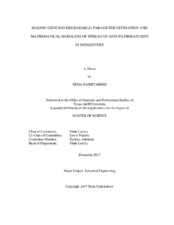| dc.description.abstract | Mosquitoes can transfer a lot of dangerous infections which place a massive burden on human health. Scientists have achieved significant progress in the last decades in the detection and management of mosquito-borne diseases; however, these diseases continue to threaten human life.
In the last decades, gene drive systems have been considered as a biological conversion method to prevent transmission of vector-borne disease. Through this approach, scientists have been trying to spread a trait in mosquitoes’ population by altering their genetics so that mosquitoes become resistant to the disease. In this case, mosquitoes cannot get infected and hence, we do not need to worry about the disease transmission by mosquitoes. However, genetic alteration has risks and scientists do not know how the new genetic will influence the ecosystem; what will be the potential mutation and if the new genetic does not work as expected, how it is reversible? Hence, none of the gene drive methods has been conducted in nature yet.
In this thesis, we studied the biodegradability of an engineered gene that can get spread through the population by a gene drive method and then eliminate itself returning the genotype into the wild-type genetic structure. A mathematical model was constructed to study this feature for five different gene drive systems. Based on simulation results, three of them succeeded while one succeeded after modification in mechanism and one failed to achieve the biodegradability goal.
To validate our model, we put two parameters equal to zero that provided the results equivalent to present studies and got the results matched. Future laboratory-based experiments will be conducted to test the validity of our results. | en |


